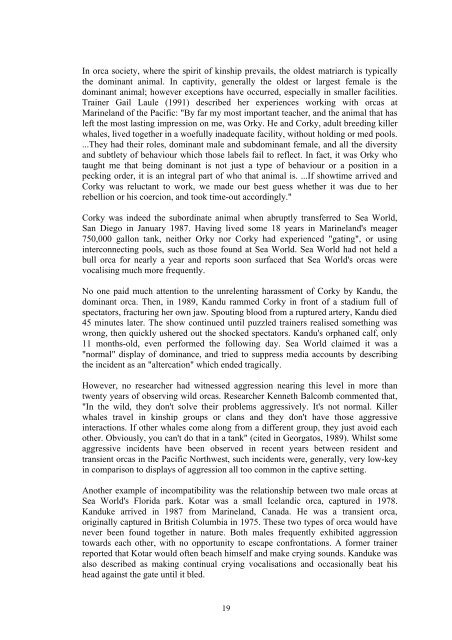Captive Cetaceans: A Handbook for Campaigners - Whale and ...
Captive Cetaceans: A Handbook for Campaigners - Whale and ...
Captive Cetaceans: A Handbook for Campaigners - Whale and ...
Create successful ePaper yourself
Turn your PDF publications into a flip-book with our unique Google optimized e-Paper software.
In orca society, where the spirit of kinship prevails, the oldest matriarch is typically<br />
the dominant animal. In captivity, generally the oldest or largest female is the<br />
dominant animal; however exceptions have occurred, especially in smaller facilities.<br />
Trainer Gail Laule (1991) described her experiences working with orcas at<br />
Marinel<strong>and</strong> of the Pacific: "By far my most important teacher, <strong>and</strong> the animal that has<br />
left the most lasting impression on me, was Orky. He <strong>and</strong> Corky, adult breeding killer<br />
whales, lived together in a woefully inadequate facility, without holding or med pools.<br />
...They had their roles, dominant male <strong>and</strong> subdominant female, <strong>and</strong> all the diversity<br />
<strong>and</strong> subtlety of behaviour which those labels fail to reflect. In fact, it was Orky who<br />
taught me that being dominant is not just a type of behaviour or a position in a<br />
pecking order, it is an integral part of who that animal is. ...If showtime arrived <strong>and</strong><br />
Corky was reluctant to work, we made our best guess whether it was due to her<br />
rebellion or his coercion, <strong>and</strong> took time-out accordingly."<br />
Corky was indeed the subordinate animal when abruptly transferred to Sea World,<br />
San Diego in January 1987. Having lived some 18 years in Marinel<strong>and</strong>'s meager<br />
750,000 gallon tank, neither Orky nor Corky had experienced "gating", or using<br />
interconnecting pools, such as those found at Sea World. Sea World had not held a<br />
bull orca <strong>for</strong> nearly a year <strong>and</strong> reports soon surfaced that Sea World's orcas were<br />
vocalising much more frequently.<br />
No one paid much attention to the unrelenting harassment of Corky by K<strong>and</strong>u, the<br />
dominant orca. Then, in 1989, K<strong>and</strong>u rammed Corky in front of a stadium full of<br />
spectators, fracturing her own jaw. Spouting blood from a ruptured artery, K<strong>and</strong>u died<br />
45 minutes later. The show continued until puzzled trainers realised something was<br />
wrong, then quickly ushered out the shocked spectators. K<strong>and</strong>u's orphaned calf, only<br />
11 months-old, even per<strong>for</strong>med the following day. Sea World claimed it was a<br />
"normal" display of dominance, <strong>and</strong> tried to suppress media accounts by describing<br />
the incident as an "altercation" which ended tragically.<br />
However, no researcher had witnessed aggression nearing this level in more than<br />
twenty years of observing wild orcas. Researcher Kenneth Balcomb commented that,<br />
"In the wild, they don't solve their problems aggressively. It's not normal. Killer<br />
whales travel in kinship groups or clans <strong>and</strong> they don't have those aggressive<br />
interactions. If other whales come along from a different group, they just avoid each<br />
other. Obviously, you can't do that in a tank" (cited in Georgatos, 1989). Whilst some<br />
aggressive incidents have been observed in recent years between resident <strong>and</strong><br />
transient orcas in the Pacific Northwest, such incidents were, generally, very low-key<br />
in comparison to displays of aggression all too common in the captive setting.<br />
Another example of incompatibility was the relationship between two male orcas at<br />
Sea World's Florida park. Kotar was a small Icel<strong>and</strong>ic orca, captured in 1978.<br />
K<strong>and</strong>uke arrived in 1987 from Marinel<strong>and</strong>, Canada. He was a transient orca,<br />
originally captured in British Columbia in 1975. These two types of orca would have<br />
never been found together in nature. Both males frequently exhibited aggression<br />
towards each other, with no opportunity to escape confrontations. A <strong>for</strong>mer trainer<br />
reported that Kotar would often beach himself <strong>and</strong> make crying sounds. K<strong>and</strong>uke was<br />
also described as making continual crying vocalisations <strong>and</strong> occasionally beat his<br />
head against the gate until it bled.<br />
19

















